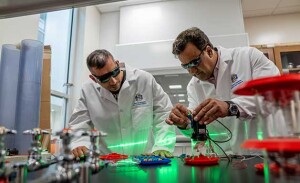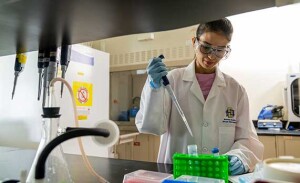South Dakota State University is looking to make a transformative move that would reshape how the university — and the rest of the country — views its research enterprise.
During President Barry Dunn’s State of the University address last September, he outlined SDSU’s new strategic plan, “Pathway to Premier 2030.” In the plan, the university is exploring a move from R2 to R1 — a change that would be nearly equivalent in impact to the 2004 transition from Division II to Division I athletics.
“It is our land-grant responsibility to help solve the multifaceted problems we face,” Dunn said. “Those solutions will also bring opportunity. We can best help our state and region solve these problems and harvest the associated opportunities with R1 status.”
Q: What does “R1″ mean?
R1 refers to the designation given by the Carnegie Classification of Institutions of Higher Education to universities with the highest levels of research activity. Only a tiny percentage of the nearly 4,000 higher education institutions in the country receive the R1 label. SDSU is currently classified under the second-highest designation from Carnegie — R2.
Q: How are the classifications determined?
Carnegie started the classifications in the 1970s to group and study institutions in the United States. The original classification method was a complex, 10-factor formula that utilized empirical data. In 2023, the American Council on Education — a group that helps Carnegie manage the classifications — announced it had made significant revisions to the classification formula. Rather than 10 factors, the method would be simplified to include two data points: research expenditures and research doctorates awarded. Because Carnegie operates the classifications on a three-year cycle, the formula will go into effect in 2025, when the next set of classifications is released.
Q: What does SDSU need to do to become R1?
With the new formula in place, SDSU will need to hit two benchmarks to be labeled an R1 university: $50 million in research expenditures and award at least 70 doctorates, in any research field, in a year. For reference, SDSU’s fiscal year 2023 research expenditures were nearly $75 million, and SDSU averaged 54 research doctorates awarded per year over the last six years.
To achieve the R1 label, SDSU will need to continuously grow its annual research expenditures and research doctoral education.
Q: Why does SDSU want to become an R1 university?
 “Earning the R1 label from Carnegie would be the result of SDSU building on its previous accomplishments and advancing as a research institution,” said Daniel Scholl, SDSU’s vice president for research and economic development.
“Earning the R1 label from Carnegie would be the result of SDSU building on its previous accomplishments and advancing as a research institution,” said Daniel Scholl, SDSU’s vice president for research and economic development.
Advancing as a research university will have a substantial impact as high-activity research institutions drive increased levels of innovation development and stimulate economic growth.
“R1 status communicates that SDSU is effective at carrying out impactful research at the highest level,” Scholl said. “It will drive economic growth, benefitting our community, state and region.”
An R1 label would also help SDSU attract and retain the best and brightest faculty members and researchers. This will provide enhanced experiences for students and separate them in their creativity and problem-solving skills for potential employers. An R1 label would also help SDSU increase the number of endowed faculty and leadership positions.
South Dakota is one of only five states that does not currently have an R1 institution. SDSU earning the R1 label will provide the state with more opportunities, both from an educational and economic standpoint.
“Looking into the future, it is clear that SDSU must continue its institutional progress and advancement to ensure vitality for serving the needs of our future students, staff, faculty and stakeholders,” Scholl said. “This work of advancing as a research university is SDSU’s logical next step as stewards of the future impact on the people we serve.”
Q: What’s the plan?
Moving from R2 to R1 isn’t something that happens overnight; a deliberate and comprehensive plan is needed to ensure the move is right for the university. A 30-person “steering team,” composed of leaders and support segments from across the entire university, is conducting an analysis of SDSU’s research, scholarship and creative activity to understand the many functions that directly, or indirectly, influence the university’s research success. The results of this analysis will guide the team as it identifies what steps will be needed for SDSU’s research university advancement strategy.
To advance as a research institution, an increase in financial support from the university, private donors and federal and state governments will be required. Previous R1 moves have shown a greater return on investment and enhanced public/private partnerships as a result of the move.
One key aspect to note: 100 campus leaders helped develop the strategic plan, “Pathway to Premier 2030,” that brought the move to R1 into focus. They universally agreed striving for R1 status must enhance the university and not change its student-centered education focus, hence the name “R1 Our Way.”
“We strive to be a growing, high-performing and healthy university,” Dunn said. “Striving for R1 status will enhance our mission and vision through effective leadership and management, fundraising and aligning strategic priorities and initiatives.”
Addison DeHaven






